#Nearby Hydroponic Stores
Explore tagged Tumblr posts
Text
Sustainable Agriculture Boosting Plant Factory Market to $196 Million by 2028
Plant factories, also known as vertical farms or indoor farms, are advanced agricultural systems designed to produce crops in controlled environments using cutting-edge technology. These facilities utilize artificial lighting, climate control, and hydroponics or aeroponics to optimize plant growth, offering an innovative solution to the challenges faced by traditional agriculture.
The global plant factory market size was valued at US$ 129 million in 2022 and is poised to grow from US$ 138 million in 2023 to US$ 196 million by 2028, growing at a CAGR of 7.3% in the forecast period (2023-2028).
Plant Factory Market Growth Drivers
To meet the rising demand for food and address the challenges posed by shrinking cropland and declining soil fertility, alternative farming techniques like vertical farming have gained prominence. These technologies are crucial for achieving food self-sufficiency, especially in countries that have historically struggled with domestic production and supply due to limited natural resources and unfavorable climatic conditions. The scarcity of arable land, poor soil quality, and increased food demand have spurred the development of innovative methods like vertical farming, which is gradually gaining traction worldwide. Vertical farming optimizes space by growing food in stacked layers or towers, offering advantages such as more efficient land use, consistent year-round crop production unaffected by weather conditions, and reduced water and pesticide usage.
Hydroponic farming, a key component of vertical farming, uses significantly less water than traditional agriculture due to its efficient water use system. Plants consume only 0.1% of the water supplied, with the rest being returned to the environment through evapotranspiration. In contrast, conventional farming often wastes water due to inefficient irrigation, evaporation, and poor water management. Vertical farming allows for efficient water use, using up to 95% less water than traditional methods. According to the Columbia University Earth Institute, vertical farmers use 70% to 95% less water compared to conventional farmers for plant cultivation.
How has the COVID-19 pandemic influenced the adoption of plant factories by restaurants and grocery stores?
The adoption of indoor farming by restaurants and grocery stores is gaining momentum, driven initially by retailer acceptance and gradually by public acceptance. Major grocery chains like Walmart, Kroger, and Albertsons have established agreements with indoor growers to source produce. Publix, based in Lakeland, Florida, has also embraced this trend by introducing an on-site trailer farm from a nearby hydroponic grower. According to a 2021 survey by FMI, The Food Industry Association, 43% of consumers expressed a preference for produce grown outdoors over that grown indoors. However, members of Generation Z, who are rapidly becoming America’s most influential demographic, showed a stronger preference for produce from indoor sources.
In recent years, many restaurants have embraced the concept of local food, advancing it further with the acceptance of hyperlocal food. This approach involves restaurants either growing their own produce or sourcing it from nearby farms, promoting sustainability and supporting the local economy while ensuring high-quality ingredients. Hyperlocal restaurants, which source almost all their food locally, have become more common. Some restaurants even have their own gardens to grow the vegetables used in their dishes.
Top Plant Factory Companies
AeroFarms (US), Gotham Greens (US), Oishii (US), Plenty Unlimited Inc. (US), MIRAI (Japan), Agricool (France), AppHarvest (US), CropOne (UAE) and BrightFarms (US).
Greenhouses Dominate Plant Factory Industry Share
Greenhouse farming offers several advantages over traditional farming methods, such as greater control over environmental factors like temperature, humidity, and lighting, which can result in higher crop yields and quality. As growers see the benefits of greenhouse farming, they may also become interested in incorporating plant factory technology into their operations, which can further increase efficiency, reduce costs, and improve crop quality. This can drive further demand for plant factory systems and technologies, leading to further growth in the plant factory industry.
Request Sample Pages to Address your Specific Business Needs
Europe Dominates Global Plant Factory Market Share
The plant factory industry has been studied in North America, Europe, Asia Pacific, South America and Rest of the World. The growth of the plant factory market in Europe is driven by a combination of factors, including increased demand for locally grown produce, government support and funding, technological advancements, environmental concerns, and growing consumer interest in sustainable and locally grown produce. Many European countries have implemented policies and initiatives that encourage the adoption of sustainable agricultural practices, including plant factories. For example, the European Union’s Horizon 2020 program has allocated significant funding for research and innovation in sustainable agriculture, including plant factory technology. Additionally, some countries offer tax incentives and other benefits to growers who adopt these practices.
0 notes
Text
New Arrivals
Suggested listening
For optimal aesthetic, view the blog here.
The author's pronouns are she/her.
This is the blog for Void Utopia, a space fantasy roleplay set far in the future.
The year is 3248 CE. For over a thousand years, mankind has roamed the stars, yet its history has remained as turbulent as ever. Despotic regimes and great disaster has left an impact that interstellar civilisation has yet to recover from, much less move beyond. Many continue to live in the long shadow cast by the triumphs of the past, as well as its countless sins. Explorers claim to chart new worlds but consistently find proof that their ancestors had been there long before. As humanity remains divided and many of the old institutions remain under new faces, one has to wonder whether we are truly progressing or merely chasing a world that has long since been burned away. Whether the loop will be broken may very well be answered before the century is through.
Despite how much one may believe the modern world is a pale imitation of prior centuries, it's easy to find the ways it has truly changed. The definition of what a human is has been massively expanded in the wake of new technologies. Thanks to the accessibility of both biological and synthetic modifications, it is easier than ever to express one's true identity regardless of wealth. At the same time, the quality and utility of such things, as well as specific modifications that represent the crudest excesses of the field, show that the divisions in society are still here and as strong as ever. It has also been far from the only paradigm shift. The calamity that knocked humanity back and wiped many other species from existence also introduced true magic into the world, the consequences of which are still being explored.
You live aboard a ship known as Ushas. One of the oldest known ships in the Orion Spur to still be operating, it has a history as turbulent as the wider Spur, having changed hands multiple times, both peacefully and decidedly less so, before settling under the control of the Salvagers Central Committee. Not only is it used in the salvaging of the countless derelict ships and stations that litter the Spur, it has long been regarded as a neutral ground by all nations and sworn loyalty to none. A true city within the void, it plays host to thousands of residents, many of whom are the descendants of people who mysteriously vanished from their home worlds or flotillas only to wake up here. Whether you or your ancestors arrived through mundane or supernatural means, you live at the intersection of all of humanity's interests. Your groceries, grown fresh from a Khumeia Biosystems-owned hydroponics chamber, are sold to you by a member of the near hiveminded Eridani Collective, and as you chew away at your meal(the fruit, as with most species from Assunzione, was designed to glow slightly), you receive a ping on your internal computer; an artifact you had stored away for safekeeping, likely an advanced piece of technology from an alien derelict, is being accessed without permission. You rush down the crowded passageways, paying no heed to the Post-Tribunalist street preacher who took one look at your cybernetics and declared you doomed as you ran by. At last, you reach the warehouse, only to be greeted by several different people standing nearby. It took you one moment to realise that many of them were potential buyers from different nations, companies, or other interest groups, another to realise that they all were armed or were accompanied by someone who was armed. The atmosphere was thick with tension even before your arrival. You let out a resigned sigh. Perhaps the preacher was right.
Over time, more information will be posted here filling out the details of the world, and perhaps other related things. The ask box is always open, so don't be afraid to pop in with a question!
Index:
Notice: Your Extranet connection is currently being limited due to high activity in your area, estimated time to complete download: Unknown
Nations:
Aquila Pact
Broken Shield Union
Coreward Commonwealth
Empire of Dominia
Zaurghesian League
Places and Minor Powers:
Ushas
Technologies:
Genelines: Lyodii
Unsorted:
Ruin Diving
#science fiction#worldbuilding#writeblr#writing#queer scifi#queer science fiction#scifi#scifi writing#science fantasy
1 note
·
View note
Text
Blog #5
Blog Q#5
What are possible ways of alleviating the food insecurity problem in the Cincinnati area (including UC campus)? Support your answers with visual examples.
Sophie Gartland: Near UC’s campus and the Corryville area, there is pretty easy access to a nearby supermarket. But in West End Cincinnati, there are roughly 253 to 732 people in this low income area without access to a nearby grocery store. Cincinnati can adapt principles from Chicagos ‘Growing Power’ and ‘Fresh Bus’. With stops at schools (public schools, University of Cincinnati), medical centers and clinics, daycare centers, housing complexes, parks, and other spaces. I am connecting the West End desert area and the University of Cincinnati as an example in the graphic below:

Image by: Sophie Gartland
Similarly to the bus in Chicago, Cincinnati could find an affordable way (by donation, etc) to convert a large bus into a means of transportation for fresh foods for University students and low income areas. Similarly to Chicago, Cincinnati's fresh bus will focus on the implementation of fresh produce; ‘kale and mustard greens, Honeycrisp and Cortland apples, cherry tomatoes and avocados. A refrigerated section offered salad mixes and fresh herbs: thyme, oregano, sage’ (Fresh Moves Delivers Vegetables to the South Side of Chicago by Bus).
Siobhan Bracken:
The issue of hunger in Cincinnati is a major issue, 28.7% of citizens of Cincinnati struggle with poverty. Those who struggle with poverty can not afford fresh fruits and vegetables and often do not have grocery stores in their neighborhoods. A solution to this issue is to encourage and create community gardens. Urban farming and community gardens are wonderful ways to increase the amount of fresh produce and make it accessible to all. Community gardens allow for the neighborhood to be connected to the food they eat. Additionally, this would increase the amount of healthy food available to people in Cincinnati. Urban farming also decreases the amount of fossil fuels used to transport produce. Overall urban farming and community gardens are good for the community and for the planet.
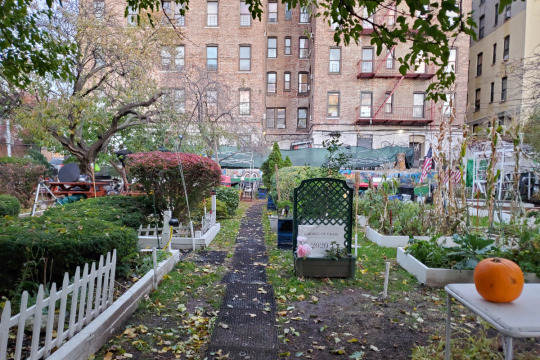
Trinity Finch: Mobile markets and grocery carts have the ability to serve communities on a rotating basis. With that being said, grocery carts can serve many communities in a short span of time. They are low cost and easy to access for the communities around them. In food deserts where access to healthy food is limited and people may have to travel long distances to access grocery stores that have fresh food, mobile markets can provide those necessities to everyone. Here in Ohio, there is already practice of these mobile markets. In Cleveland the Bridgeport Mobile Market travels to people's living spaces, work areas, as well as places of worship to bring fresh fruits and vegetables to their communities. There are only four main steps to starting your own mobile market: relying on proven business strategies, researching successful mobile markets, developing private partnerships for funding, and developing financing packages for each mobile market project. With these steps in mind, we can reduce food deserts in our communities.
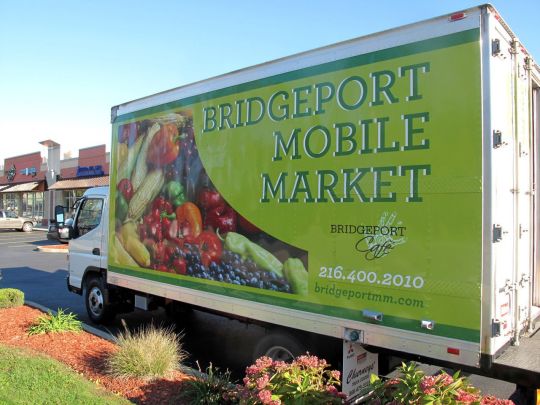
Debbi Snook, T. P. D. (2013, June 26). Produce truck to serve Cleveland's 'food deserts'. cleveland. Retrieved February 21, 2023, from https://www.cleveland.com/taste/2013/06/produce_truck_to_serve_clevela.html
Gabriel Manzano: Vertical farming is a type of indoor farming system that involves growing crops in vertically stacked layers using advanced technologies like hydroponics, aeroponics, and artificial lighting. This system can alleviate the food insecurity problem in the Cincinnati area and UC campus by providing year-round crop production, efficiently using space, and reducing transportation cost. Vertical farming allows for year-round crop production, regardless of weather conditions. This can help provide a consistent and reliable source of fresh produce, which can be especially important in areas with harsh or inconsistent winters, like Cincinnati. Vertical Farming also reduces transportation cost because the crops are grown locally. This can help make fresh produce more affordable and accessible to local residents, including those on the UC campus. Vertical farming helps provide a reliable source of fresh produce which increases food security by ensuring that there is a consistent supply of fresh produce available, regardless of external factors.
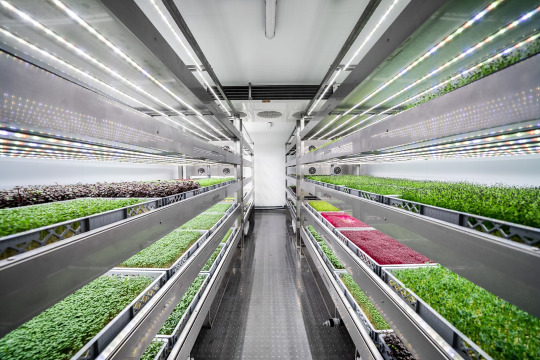
(https://wikifarmer.com/what-is-vertical-farming/)
Conclusion: Kayra Koprulu
In conclusion, there are a variety of ways to reduce the food insecurity problem in the Cincinnati area (including UC campus). These ways being bus transportations to local fresh food supermarkets, creating community gardens, and mobile markets. While these options are not the only ones, there are many more to list. These acts of service can easily be funded by donations if the public is willing to help. Other ways that can be implemented to benefit Cincinnati and even other poverty stricken cities could be raising awareness to donate to local food banks and building up more food banks in more cities and even towns. Even something as easy as making go fund-me type donation foundations and raising awareness on social media platforms by posting their links. It’s easy and quick to click a link therefore, more donations can be made. More and more accessible places for people who struggle to get healthy and nutritional foods will be possible, but only with the help of the public to support.
-Kayra Koprulu
Question: What can the city of Cincinnati do to encourage companies like kroger to move into food deserts?
0 notes
Text
Grow Your Own Indoor Garden with the Right Grow Room Supplies
Building an indoor grow room is the most exciting thing you'll do on your journey to living a better life. The size, shape, and appearance of your grow room will largely determine the results you enjoy in harvesting, as well as in the quality of your product. By investing in Indoor Grow Room Supplies and equipment you can improve your yield and save money along the way.

The Grow Depot has your garden covered with our complete range of Indoor Grow Setup for Sale to suit your needs. We can help our clients grow their gardens and plants to their full potential. Indoor grow room supplies are critical for successful indoor gardening. Whether you are new to growing or an experienced gardener, having good indoor grow room supplies can really help your garden grow faster, better and healthier.
As a grower, you need the best equipment and supplies to keep a perfect balance between indoors and out and harvest healthy cannabis plants. With years of collective experience for all growing stages, our Complete Indoor Grow Systems are the best solution for you. Indoor hydroponic growing using a professional setup can be highly rewarding. There are many ways to set up your own indoor grow room and there are many different ways to create the perfect grow environment which is tailor-made for your particular plant needs.
The Grow Depot is your absolute best choice for all of your indoor gardening needs. We go above and beyond to provide you with products that make every step in your gardening process easier. If you're looking to grow your own herbs, vegetables, or flowers indoors, or just need extra growing space to continue your projects in the meantime — Grow Depot has your needs covered. You can find everything you need for a successful indoor garden right here! To buy our products, call us now at 1-647-748-4769!
#Nearby Hydroponic Stores#Hydro Garden Store#Complete Indoor Grow Systems#Hydroponic Near Me#Hydroponic Dealers Near Me#Cheap Grow House#The Grow Depot Tent#Grow Room Tents#Grow Room Kits For Sale
0 notes
Text
Fort Galfridian: It Exists And Sometimes I Wish It Didn’t
(or, nothing about this damn station makes sense, have some theories thrown at the wall accompanied by the sound of me losing braincells)
((Disclaimer: I can neither write coherantly nor do physics at anywhere near the level required to understand this stuff))
And with that, let’s go!
I have split this into 4 parts: Facts we know from various works, Word of God from twitter, me hypothesising about What It All Means, and things I have Zero idea about
*
Facts about the station
From lyrics
“fluorescent sun”[1], “rusted metal wasteland”, “scorching steel floor”
“Annwn, the lightless depths of the outer station”, “vast inner wastes”, “The inner level of the station curved back in upon itself”[2]
“a space station of unparalleled size and power, in close orbit to their sun”
“in the old Captain’s cabin, many levels and days travel away.” [3]
“bandit-ridden sub-levels”, “lightless depths of the outer station, where the radiation shielding was weakest”
“They seek the GRAIL in the depths beneath”[4]
“She comes up while I am fishing”, “Even here in hydroponics”
“rise upwards through the station until they found themselves in centre of the round table”[5]
“nearby Camlann wastes”
From fiction
“Dirty water would fill his lungs”[6], “in the flooded sector”
“The quality of the light had not changed” compared to “daybreak” (from The Wake)[7]
“a couple of mushrooms from a higher level”
*
Word of god
As far as Jessica Law can remember “[the station] is cylindrical”[2]
There is something weird with the sun’s shape (actual sun as in Avalon? Or artificial sun?)
Jonny Sims sad “the sun isn’t f***ing cylindrical!” (paraphrase)
There are no snakes (present in the original myth)on board, scorpions being their replacement
There was a story planned about the scorpions, “ unseen and forgotten in a food shipment”, and how their descendants spread through the station, but it was never finished
*
Theories
There’s an artificial sun onboard, and if it’s cylindrical it could just just be fluorescent tubes?
Central cylinder with rings round the outside?? These rings would sit about at the centre of the main cylinder, allowing both upper and lower levels to exist in relation to a fixed point.
Lower gravity on the outer rings too, which could contribute to the Saxons looking so different from the Camelot folk
Along with 2, offers support for a tall central cylinder?
Central cylinder sticks out below out rings? The “upper levels” are sections of the cylinder that would be “above” the outer rings, with the inverse true for the “lower levels”
There’s some sort of central elevator?? It leads from the captain’s cabin to the centre of the Round Table
There’s water, stored in open pools (this is not efficient! why does this exist!) This water is deep enough to drown in
Some form of day/night cycle. It doesn’t work on the outer reaches of the station? (Radiation shielding also not working out here)
Scorpions are a good source of fat, protein, energy and minerals (apparently). Could be a food source that escaped?
*
Everything else
Why are there scorpions?? For Story Purposes, it makes sense that they’re the only animals really mentioned, but what kind of starfaring civilisation would decide to put deadly animals in a closed environment like this?[8]
Cylindrical sun??
*
In conclusion!
I never want to think about this again! Any other ideas are more than welcome
#help i'm Suffering#yes I *know* it's scifi and we don't have to consider these things too hard!#but consider this: what if we *did* consider these things too hard#the mechanisms
44 notes
·
View notes
Text
I've got an idea for a Little Shop of Horrors au thing. It takes place in a modern day college after the events of LSOH. I've seen some crazy and wonderful fandom things on here, so I think this would belong here on Tumblr
There's three main characters: Marten, Lillian, and Andre.
Marten is an Asian American engineering student who wants to go into hydroponics and related space colonization tech. He's friendly, loves to socialize, is very empathetic, and is attentive to details.
Marten is a hopeless romantic and has unrealistic expectations about relationships. He also has an absolute black thumb and somehow kills everything but moss. He's disappointed in his gardening skills because he's taken a liking to botany student Lillian.
Lillian is an African American botany student who closely follows in her professor's footsteps. She has big dreams for the future and wants to run her own botanical gardens someday. Generally she's a nice person and a loyal friend. She loves conversation and gets really excited when sharing new things she's learned about plants.
However, don't say anything rude about her, to her face or otherwise. She's quick to defend herself and very sharp tongued. This often causes conflict between her and her boyfriend Andre.
Lastly, Andre, an African American dentistry student. He's a 3rd generation student at this University and is kinda like the Orin of the group. He's a grumpy, depressed introvert who doesn't know what to do with his life.
If Andre's disposition doesn't push people away, he'll do it physically. This leads to conflicts with Marten and his girlfriend Lillian. He wishes that he could be better, but struggles to ask for help.
Though he hates to admit it, he has a soft side. Andre loves animals, especially rabbits. He owns a plush rabbit that he tends to hide from other people.
There's another couple characters, and that's Professor Krelborn and his wife Audrey. Yep, Seymour's a professor now.
Regarding relationships, Andre and Lillian are dating but growing apart due to constant fighting between them. Marten and Andre are roommates and maintain a neutral grounds, though Marten's affection for Lillian puts a strain on things.
Seymour and Audrey have been happily married for a few decades with kids and now grandkids of their own. Most of their children were adopted.
Now for the actual story:
Things start out with Marten riding his bike from the dorms to campus, flirting with a couple girls on the way there. As Marten makes his way up a small path next to a pond, there's Andre laying on a park bench with his legs crossed. Unfortunately, Andre has blocked Marten's path and they both end up tumbling into the pond.
While they crawl out of the water and Andre lets out a string of swear words that would make Samuel L. Jackson proud, Marten notices a strange plant like a cross between a lily pad and a Venus flytrap floating in the water. The plant is no bigger than a quarter, and he stuffs it in a discarded water bottle so he can show Lillian later.
Marten catches Lillian after class to show her the weird plant. She's impressed and suggests showing it to Professor Krelborn. The professor, however, isn't so delighted by this strange plant. He turns white as a sheet and identifies it as an invasive carnivorous plant.
Prof. Krelborn offers to trade Marten a different carnivorous plant in exchange for the little sprout from the pond so it can be destroyed. Marten, horrified by the suggestion, refuses and takes the plant back to his dorm, where he sets up a hydroponics tank with Lillian's help.
The two name the plant Leaf Erikson and soon discover that it feeds on blood after it ate some guppies they added to the tank. Over time, Leaf grows large enough to eat a rat whole and requires more and more blood. Andre could care less about the plant, but he's increasingly disturbed by its hunting methods.
One evening, Leaf isn't doing so well and starts to partially wilt. Not knowing what to do, Marten panics and asks Lillian for advice. She suggests giving the plant more blood, so he runs down to a nearby store and picks up a cheap raw steak.
Leaf begins to lap up the blood and juices, slowly pulling the steak and Marten's hand closer to its jaws. Then the plant bites Marten and starts drinking his blood.
Lillian had just arrived at the boys dorm with plant supplies when she hears screaming. Andre is also walking in when he hears this and they run to the dorm room to find Marten struggling against the plant.
Andre reaches into Lillian's bag, grabs a random gardening tool, and stabs into the plant until it lets go. Lillian calls for an ambulance while Andre does his best to stop the bleeding and keep poor Marten from passing out.
At the hospital, Marten is in stable condition and the trio agree upon the cover story of a feral dog attack. Feeling that the professor knows more about these plants, Lillian informs him of the attack and what happened to the plant.
Professor Krelborn rushes to the hospital to learn more about what happened, while Marten starts to develop strange powers...and feel very hungry.
That's all I've got for now. I think the plant hybrid shenanigans would make an interesting combination with the themes of LSOH, especially where morals come into play. Thanks for taking the time to read this. I had a lot of fun creating this au.
#little shop of horrors au#lsoh#little shop of horrors#alternate version#fanfic#original character#seymour krelborn#audrey fulquard#audrey ii#audrey 2#twoey
12 notes
·
View notes
Text
Gardening inside the Greenhouse

Most homes have a front yard or a lawn with trees and grass. The individual can without much of a stretch roll out a couple of improvements then it will be better than it was previously. A decent leisure activity that a few people have taken in the extra time is cultivating and something very similar should be possible on the off chance that one chooses to have a nursery.
The primary thing that should be done is evaluate the zone where the nursery will be. On the off chance that there isn't that much space in putting an unattached rendition, at that point maybe joining the nursery to the house is a smart thought.
The principal thing to be done is to quantify the zone. The nursery ought to have enough daylight for the plants and shade when it gets excessively hot. This should be possible by mentioning some objective facts at various times.
The home might be influenced by the cool atmosphere or the warmth throughout the late spring. Arrangements should be done to introduce and warmer and a ventilation framework which could to counter the danger and cause the blossoms to develop in the nursery.
The sort of radiator to be utilized for a nursery can be controlled by power since the zone isn’t that huge. Getting something like those that utilization oil or gas may possibly be required if the structure is extended.
The two frameworks will give the nursery worker adequate oxygen and carbon dioxide that is required for the plant to develop.
Another method of giving plants enough space to develop is the kind of boards utilized for the nursery. Since plants need daylight to develop, the sort of material utilized for the windows and roof are significant.
Generally, glass can carry out the responsibility yet a few investigations have demonstrated that an excess of daylight goes through and kills the plants. To keep away from this, boards made of film, plastic or Plexiglas is vastly improved.
The nursery ought to likewise utilize the perfect sort of blossoms that will endure the atmosphere. The individual can ask the agent at the cultivating store or take a gander at the mark posted on each plant before purchasing and bringing it home.
When everything is prepared, the individual has two alternatives. The first is draw the plan at that point go to a provider who can do that or go legitimately to the temporary worker to cause an attracting at that point to have it made.
On the off chance that the individual doesn’t have a thought where to begin, one can take a gander at how the others who do this as a leisure activity in the area do it. The individual can likewise visit the arboretum or take a gander at cultivating magazines just to get a thought what sort of nursery is best for the home.
The dirt in that piece of the house ought to be set up before development is in progress. Fundamentally, this is simply to encase the territory so it is okay if there are plants in the site as of now.
The nursery can later be improved to have soil as well as have water consistently that will upgrade the plants development. This procedure which is finished by ranchers to build crop creation is called hydroponics cultivating.
At the point when the plant specialist, has enough cash, soil can be changed to water channels that discharge water blended in with supplements to the plants. There are different approaches to do this and doing some examination in transit this can be embedded will get the plant specialist going in good shape.
Something else expected to appropriately work in the nursery is having the correct hardware. This can without much of a stretch be bought at the nearby planting store and these ought to be put away appropriately when not being used.
It will be a smart thought to have this bolted to keep kids from playing with it and mishaps from occurring.
Cultivating doesn’t consistently must be finished by an expert. The individual can do in an imaginative manner to make the house stick out. By doing some exploration first before having it introduced, the spot will truly look incredible when development has been finished.
By realizing the correct procedures in keeping up the nursery and planting the correct blossoms, this spot will be another room that will truly cause the person to feel at home.
1 note
·
View note
Text
Rimworld Update 1
We rescued another heavily injured colonist who was stranded over a day’s hike away, and recruited another wanderer who stumbled upon our base, for a total of 6 survivors.
Winter was initially harsh, but once we found a way to grow rice indoors with sun lamps, we were able to sustain a reasonable food store. Unfortunately, to get us through the growing of the first crop, we had to slaughter all our animals except Matthews’s dog.
Traders come through every now and then. It would be a lie to say we don’t think of robbing them, especially the caravans of 1 or 2. More labor would be a welcome addition as well; there’s so much to do. Unfortunately we seem to be far better off than the most recent groups to walk by our humble outpost, there’s not much they can offer us that we don’t already have.
We’ve set up solar panels, capacitors, and a small hydroponics room for growing medicinal herbs, but they’re proving difficult to grow.
In other news, we found that part of a nearby mountain was composed of compacted steel and machinery, all of which seems relatively salvageable. We hope to use it to outfit our base with more solar panels, and make the switch to electric lighting. Greywolf is working on some automated turret tech too, which’ll hopefully see the light of day soon. There’ve been too many close calls with raiders and feral animals lately.
2 notes
·
View notes
Text
Do You Know The Requirements of An Indoor Garden?
In case you are new with the process of gardening and you wish to start with indoor gardening then before doing anything, you have to be conscious of the requirements of an indoor garden. In case you do not know something then starting from the fundamentals would be the greatest thing for you to think as you have to incorporate all of your informative elements and knowledge before practically applying anything. As people, we want water, air and a proper condition to grow and survive; think regarding the plants in similar way. It is a growing, living thing that wants suitable aspects of atmosphere and life.
A few of the gardeners love to have outdoor gardening because their very first step of the relaxation, in case you are the different ones, then indoor gardens have to be your main concern, you can think about having all the correct things that you want for the reason. Supplies of indoor garden such as High Quality Grow Tents Canada would confirm that you have complete management of the things such as, composition and soil mixture, nutrient placement, water and most of all the natural pesticides and fertilizers that you would be utilizing in your indoor garden.
To make your indoor garden perfect and in excellent condition, you can have so many important considerations as well. You can select to plant in good looking and designer pots, in soil area or also the hydroponics way that is utilized within the water and its composites or only the water alone. Confirm that you know regarding hydroponics environment and every possible requirement of hydroponics as they are used in a different way as evaluated to the conventional techniques of the gardening.
For a normal indoor garden, firstly you would need to determine and design the pot’s sizes for plantation of different types of plants. There will be different pot’s styles available in the garden stores already having the best type of fertilizers within them thus you only need to select the excellent one in order to start your enjoyment and fun with indoor gardening. You must then choose a specific location for the pot’s placement and Grow Lights Online Canada for proper lighting arrangement. The lights that the plant will receive are yet one more requirement of your indoor garden that you should think at all cost. Though, you have to be careful of the warmth and heat your plant will be getting from the nearby atmosphere as you could find yourself in the requirement of appropriate ventilation along with it as well at some level.
Organize the plants as per to their size and height. You can check Electrical Ballast Price Canada and make use of it. You can have perfect backgrounds made out of stylish shrubs and wood. You can contain different types of fruits, flowers and also vegetables in your garden.
Above discussed are some fundamental requirements of an indoor garden, think about every big and small aspect about indoor gardening before starting anything.
1 note
·
View note
Text
Mars Base discounted with support for Steam Play
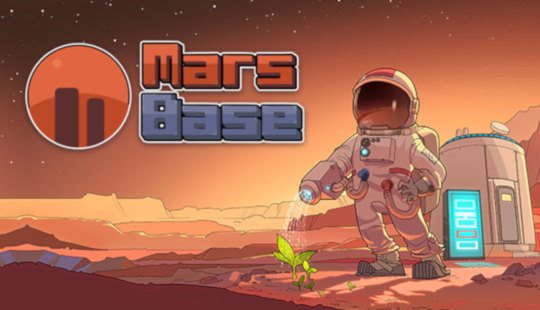
Mars Base farm sim game works on the Linux powered Steam Deck via Windows PC with Mac. All thanks to the support of developer KZ Games. Currently available with a discount on Steam and Humble Store. Mars Base the 16-bit out of this world greenhouse farming sim. This is also the work of developer KZ Games to colonization on Steam. Paint the red rocks green and embark on a mission of interstellar botany in Mars Base. Due to terraform Mars with lush agriculture. Create a self-sustaining civilization full of thriving crops on the harsh Martian elements. Craft tools, brave dust storms, and breathe life into the barren soil. Doing so by mixing your own…ahem…”organic waste” with the scarlet gravel to fertilize terrain. Expand colony functions from one person and low-yield manual labor up to modular planters. Including hydroponics and automated robots to provide for an entire society. Engines also launch toward the Steam Deck.
It already works on Steam Deck, so I'll go ahead and say "Yes".
This is the Discussions post from last month. Now that there is a sale with some confirmation for Proton. Now would be the time to save and explore the farm sim game.
Mars Base - Launch Trailer
youtube
Break ground for the scenic Erebus Montes region of Mars. Due to build and upgrade a home base with paved roads, crafting facilities, research labs, solar power plants, and greenhouses. Every two Martian years, a fresh batch of new colonists arrive from Earth. Learn from the latest newcomers in Mars Base and interact with them. Due to swap stories and take on fresh side jobs. Unearth (or…unMars?) the rich geological underground and discover mysteries. Then access rare Martian resources by digging into the history of the Amazonis Planitia region. Once food is on everyone’s table, there’s still plenty to do in Mars Base. Explore layered lava tubes, decorate beautiful bases, and race radical rovers. Then build new rockets to visit nearby moons or bundle fresh produce. So you can personally whip up some out-of-this-world meals in the kitchen. Colonizing new planets means fashion trends await to be set. Express yourself as the titular space farmer. Along with various space suits, hairstyles, skin tones and more. Mars Base farm sim game is discount 33% on Steam. Priced at $13.39 USD / £10.37 / 13,39€. Regular price on Humble Store. Along with support for Linux via Proton with Windows PC, as well as Mac.
0 notes
Text
Plant Factory Industry Future Outlook, Global Trends, Industry Share And Top Key Players
The global plant factory market size was valued at US$ 129 million in 2022 and is poised to grow from US$ 138 million in 2023 to US$ 196 million by 2028, growing at a CAGR of 7.3% in the forecast period (2023-2028). Plant factories, also known as vertical farms or indoor farms, are advanced agricultural systems designed to produce crops in controlled environments using cutting-edge technology. These facilities utilize artificial lighting, climate control, and hydroponics or aeroponics to optimize plant growth, offering an innovative solution to the challenges faced by traditional agriculture.
Hydroponic farming, a key component of vertical farming, uses significantly less water than traditional agriculture due to its efficient water use system. Plants consume only 0.1% of the water supplied, with the rest being returned to the environment through evapotranspiration. In contrast, conventional farming often wastes water due to inefficient irrigation, evaporation, and poor water management. Vertical farming allows for efficient water use, using up to 95% less water than traditional methods. According to the Columbia University Earth Institute, vertical farmers use 70% to 95% less water compared to conventional farmers for plant cultivation.
Post-Pandemic Growth: How COVID-19 Accelerated Plant Factory Adoption in Restaurants and Grocery Stores
The adoption of indoor farming by restaurants and grocery stores is gaining momentum, driven initially by retailer acceptance and gradually by public acceptance. Major grocery chains like Walmart, Kroger, and Albertsons have established agreements with indoor growers to source produce. Publix, based in Lakeland, Florida, has also embraced this trend by introducing an on-site trailer farm from a nearby hydroponic grower. According to a 2021 survey by FMI, The Food Industry Association, 43% of consumers expressed a preference for produce grown outdoors over that grown indoors. However, members of Generation Z, who are rapidly becoming America’s most influential demographic, showed a stronger preference for produce from indoor sources.
Greenhouses Dominate Plant Factory Industry Share
Greenhouse farming offers several advantages over traditional farming methods, such as greater control over environmental factors like temperature, humidity, and lighting, which can result in higher crop yields and quality. As growers see the benefits of greenhouse farming, they may also become interested in incorporating plant factory technology into their operations, which can further increase efficiency, reduce costs, and improve crop quality. This can drive further demand for plant factory systems and technologies, leading to further growth in the plant factory industry.
Plant Factory Market Growth Drivers
To meet the rising demand for food and address the challenges posed by shrinking cropland and declining soil fertility, alternative farming techniques like vertical farming have gained prominence. These technologies are crucial for achieving food self-sufficiency, especially in countries that have historically struggled with domestic production and supply due to limited natural resources and unfavorable climatic conditions. The scarcity of arable land, poor soil quality, and increased food demand have spurred the development of innovative methods like vertical farming, which is gradually gaining traction worldwide. Vertical farming optimizes space by growing food in stacked layers or towers, offering advantages such as more efficient land use, consistent year-round crop production unaffected by weather conditions, and reduced water and pesticide usage.
In recent years, many restaurants have embraced the concept of local food, advancing it further with the acceptance of hyperlocal food. This approach involves restaurants either growing their own produce or sourcing it from nearby farms, promoting sustainability and supporting the local economy while ensuring high-quality ingredients. Hyperlocal restaurants, which source almost all their food locally, have become more common. Some restaurants even have their own gardens to grow the vegetables used in their dishes.
Europe Dominates Global Plant Factory Market Share
The plant factory industry has been studied in North America, Europe, Asia Pacific, South America and Rest of the World. The growth of the plant factory market in Europe is driven by a combination of factors, including increased demand for locally grown produce, government support and funding, technological advancements, environmental concerns, and growing consumer interest in sustainable and locally grown produce. Many European countries have implemented policies and initiatives that encourage the adoption of sustainable agricultural practices, including plant factories. For example, the European Union’s Horizon 2020 program has allocated significant funding for research and innovation in sustainable agriculture, including plant factory technology. Additionally, some countries offer tax incentives and other benefits to growers who adopt these practices.
Plant Factory Leaders: How AeroFarms, Gotham Greens, and Others are Shaping Agriculture
· AeroFarms: Transforming urban agriculture with over 14 years of expertise in aeroponics, AeroFarms builds large-scale indoor vertical farms for high-quality baby leafy greens and microgreens. With a focus on local freshness and a patented growing cloth medium, AeroFarms partners with global leaders like IKEA and Goldman Sachs to bring sustainable farming solutions to the US and beyond.
· Gotham Greens: Pioneering urban agriculture, Gotham Greens operates climate-controlled, solar-powered greenhouses across American cities. By leveraging hydroponic technology and machine learning, they produce fresh, local produce year-round, all while minimizing environmental impact with their sustainable energy practices.
· Bowery Farming Inc: As the largest vertical farming company in the US, Bowery Farming Inc. uses cutting-edge technology, including AI and robotics, to grow organic, pesticide-free produce. Their smart farms, powered by BoweryOS, ensure fresh, flavorful greens are available at major retailers and grocery stores across the Northeast and Mid-Atlantic regions.
· Oishii: Revolutionizing the fruit industry, Oishii’s vertical farms in the US produce the renowned Japanese "Omakase Berry." By mimicking ideal growing conditions and eliminating pesticides, Oishii delivers strawberries with unmatched sweetness and quality, advancing sustainability in the vertical farming sector.
0 notes
Text
The Complete Guide To Hydroponic Sanitation & Sterilization
Sterilizing and sanitizing hydroponic equipment is really important. Why is that?
Diseases
Priority for cleanliness in your grow room affects the health of your plants. If you do not keep your room clean you are opening up pathways for disease and fungal pathogens.
Unclean Produce
It would harm your health if you are not being clean in your grow room and around your plants. You are going to be harvesting produce that is not clean and probably not healthy for your customers.
Certifications
Another reason why cleanliness and sanitation are important would be certifications and standards. There are many certifications and standards out there whether you're trying to grow organic or get any other certification.
There are usually very detailed standards when it comes to cleanliness and sanitation. So make sure you check with that specific licensing board for that certification to make sure you are doing everything correctly.
Difference between sanitation versus sterilization
Sanitation is just general cleanliness of your grow rooms. So things like removing dead plant material from your towers cleaning up any spills or any messes sweeping mopping cleaning out your filters scrubbing down and keeping your harvest and planting area clean and well prepped. These are things that all make sanitation and sterilization seem much different. Sterilization refers to killing microbial life like bacteria, microbes, fungi, anything small like that.
Sanitation and sterilization are typically accomplished with things like hydrogen peroxide bleach and antibacterial products like Lysol. It is essential to make sure you are killing off the microbial life. So, in conclusion, you will be wanting to use both sanitation and sterilization in combination to make sure that your grow room is as clean and healthy as it can possibly be.
Materials you need to use
A various array of cleaning utensils like scrubby sponges stiff bristle brushes are needed. Long handle brushes are great for getting in hard-to-reach areas like your reservoir when you want to clean that out. It is also very important to have gloves and eye protection you will be using some various chemicals throughout your sanitation and sterilization processes.
You also need things like scissors to help you remove dead plant material that may be clinging to your plants. You will also need various cleaning agents to help complete this. You will have things like bleach and hydrogen peroxide. Bonus points if you go for food grade hydrogen peroxide - it is a little bit more highly concentrated than what you can buy on the store shelf. However, if you can't get that easily regular peroxide will work.
We also like to use an agent for general sanitation around the room. That's just for cleaning up spills and messes that are not killing microbial life. So a general degreaser like this works really well if you don't like using things like that. You can definitely use vinegar for cleaning that will work as well. One more option that we use for sanitization that you might not have up there is an ozone machine. Now ozone can be pumped into the air of your grow room and it can sterilize basically anything it comes into contact with including human life, which makes it a little bit dangerous. Because you cannot be around while that ozone machine is running.
If you are using ozone to help sanitize your hydro solution by pumping that ozone into your nutrient reservoir, it is much safer for human use. You don't have to worry about the toxicity of having that ozone running and having people nearby. So you can add ozone in your reservoir to help keep that clean.
Obviously, you would not want to just go dumping bleach or peroxide into your reservoir willy-nilly. You're probably going to kill your plants. There is a safe amount of peroxide that you can add to your reservoir while you have plants in it bleach however I would not recommend adding while you have plants in your system.
Bleach is more for sterilizing things while you have nothing in your system. So you can flush it out and start fresh and obviously with cleaning agents. For sanitation, these really probably should not be getting into your reservoir. They probably will kill your plants however using these to clean things around the general area of your plants is perfectly safe as long as you are not getting them on the foliage.
How To Clean The System
First, start with sanitizing and sterilizing your room so you would want to sweep and mop your floors. You would want to clean scrub down your walls things like that anything to keep your room just neat and tidy have fewer problems with mess. You're going to have fewer problems with plant diseases. You want to keep your equipment sanitized and sterilized as well - this one is really important. You want to keep your hydro system clean and sterilized so you want to keep all the tools that you use with it cleaned and sterilized.
You're opening up the possibility of infection in your plants every single time you cut with a non sterilized piece of equipment. That is the key to limiting the spread of disease. The more cleaning that we do for our equipment with a vertical system the better. That helps you keep the top lines very cleaned out and prevents clogging. We also like to vacuum out the drainage that keeps any debris out from clogging up our drainage and causing floods. And generally, we just like to give a good sterilized wipe down of tower faces, gutters, rack faces - anything like that, keep it nice and clean. When it comes to your reservoir you will either want to occasionally scrub down the sides of the reservoir or you can use a pressure washer if you don't have a pressure washer.
This is where a big brush really comes handy to reach into those hard to get places of your reservoir. But once you have scrubbed it down you can always go ahead and sterilize your reservoir with something like bleach or peroxide. And then flush your tank out; fill it up with clean fresh water and start new. We also like to keep our filters very clean - remember to check your swirl filter. If you're using a larger system that one gets all your large particulate matter.
This is important especially if you're running something like ozone or hydrogen peroxide on a regular basis in your reservoir. Otherwise just by keeping your Y-filter cleaned out and sanitized is good enough when you're cleaning your tower media. Remember to remove as many roots as you can. You also may want at some point to sterilize the media from your towers. You can do that with dilute bleach and you can also do that with hydrogen peroxide. There are two ways you can go about doing this - you can either put these into your reservoir or run them through the towers. And let it cycle through your entire system. If you are doing bleach, remember to flush the system after doing that another option is to get a flood table tray. That you can actually dunk that tower media into your dilute bleach solution.
So you may be asking yourself we've cleaned just about everything in the grow room.
Now, what about the plants? Do you sanitize and sterilize the plants? You may want to remove your dead growth. If you leave that behind, it can open you to fungal or bacterial infections in your plants or any other nasty diseases like that. You don't necessarily need to sterilize your plants all the time. A lot of these sterilizing agents will kill your plants, however, you can do things like fungicidal sprays and dunks.
But know that if you do need to sanitize and sterilize your plants, there are fungicides available to help you do that whenever you want to be sanitizing and sterilizing. This is a very wide open subject that's up for debate it really depends on the size of your system. If you're doing just a little home system, you can supply yourself. You're probably not going to be cleaning stuff out as much as someone who has an organic certification and are producing thousands of crops. They're going to be cleaning all the time.
Usually, most people in a hobby market can get away with just cleaning when they need to, so it doesn't cause problems of fungal infections. Bacterial infections don't cause drainage and flow problems within their reservoir pumps, drip emitters. So you don’t get to know. If you have a certification or a license, check with that licensing board that certification board for their cleaning standards and their schedule. If you are not licensed and not certified, we still recommend keeping up to a regular cleaning schedule. Try doing everything at least once a week if not more frequently. You may need to do it more frequently to prevent things like clogs. And you're going have random spills and messes if you do not do it. Remember that cleaning is almost a daily activity in the professional hydroponic world.
Safety Guide
We're going to give you a little bit of safety do's and don'ts for these two topics to make sure you're not making any large mistakes in your hydroponic setup. There are lethal doses of these cleaning and sanitation products that we have listed here. Obviously, you should not be using super-strength cleaners and degreasers on plants. You should not be dumping these into your reservoirs. You're going to kill your plants if you do that. Some of these other ones like hydrogen peroxide can be used in hydroponic solutions with living plants.
In very small amounts, vinegar is also very safe. However, bleach is going to kill your plants pretty quickly. There must be gloves and safety glasses to protect your hands and eyes. They can be fairly harsh chemicals. Remember if you do go the route of peroxide and obtain food grade hydrogen peroxide remember that food grade is much more concentrated than what you get on the store shelf in a little bottle. It actually needs to be treated like a caustic substance at that concentration until it is diluted in water.
Ozone can be toxic to humans. If you are pumping ozone into the air you should not have anyone working in that area. However, you can pump ozone into a liquid into your hydro reservoir and that is safe to work around as long as you're not running it constantly.
For more information and to get your own hydroponics setup, visit Herboponics.
2 notes
·
View notes
Text
Hydroponic Farming Setup Large-scale
Hydroponic Farming Setup Large-scale Hydroponic Farming Setup. Urban areas will require more large-scale hydroponic farms as they become more populated each year. A cutting-edge farming technique called hydroponics will address current and upcoming issues in and around urban areas. So that people can obtain their food in the city rather than from rural farming areas, owners of large-scale hydroponics farms can sell their products to nearby restaurants, businesses, and individuals. The fundamentals of how to set up a large-scale hydroponics farm will be covered in this article. image of Hydroponic Farming Setup 1. Develop Your Business Concept You want to start a hydroponic farm? Excellent. But to make sure your business venture is prepared for success, you must plan it out! Setup the initial and ongoing costs related to a hydroponic farm. Who will be your intended market? Are you attempting to sell to individuals, local restaurants, or grocery stores? How do you intend to market your goods? en masse? What does your company go by? Does it support the principles and values of your business? 2. Choose a Location You must choose a location for your large-scale hydroponics farm before beginning. Major cities are interested in the future of farming, so you might want to locate your company there or close by one. Your target markets will also influence where you locate your business. 3. Choose the crops you want to grow One of the most important aspects of your hydroponics farm is selecting the crops you want to grow. Find out if there are any other hydroponics farms nearby and what they are selling. Check to see if you can provide a product that will not only be simple to grow but also be in demand with your target audiences. Do you want to grow a variety of crops to appeal to different target markets, or are you planning to grow just one crop to reduce costs? 4. Choose a hydroponics growing system Consider the area where your hydroponic farm will be located and decide which type of system will be most effective given the location and the crop. An NFT setup is sufficient if you're growing lettuce or spinach because these plants grow quickly and are easy to harvest. Vertical hydroponic growing systems are best for larger crops like fruits or tomatoes. Examine the costs of various hydroponics growing systems based on the components, crops, setting, and location. 5. Lighting You should now choose the light source that will be used to grow your plants. Lighting expenses can be high, particularly when powering extensive hydroponic farms. Lighting, which includes HPS, HID, and LED bulbs, is crucial to hydroponic farming. You must carefully weigh the advantages and disadvantages of each lighting option to choose the one that best meets your requirements. The future of farming lies in hydroponic farms. Join our Facebook microgreens group and subscribe to Nick Greens' YouTube channel to learn more about hydroponics and farming. We are eager to support you in achieving your objectives! FAQ Hydroponic Farming Setup How much does it cost to set up hydroponics? 30 lakhs to Rs. 34 lakhs. In this area, we can comfortably grow about 90,000 to 95,000 lettuce plants. If you plan to grow fruit or vegetable crops, you may need a Dutch bucket system or a media-based planting bag system. What equipment is needed for hydroponic farming? Gardeners can purchase the system as a ready-made unit or as a kit. If you decide to build your own system from scratch, you will need a reservoir container, netting pot, and the following additional hydroponic tools and supplies: Wick System – Planting tray, rope wick, air stone, non-submersible air pump, and air hose. What plants are the most profitable in hydroponics? What are the 9 Most Profitable Plants for Growing Basil Hydroponics. Basil is one of India's most beloved spices - it has a wonderful aroma and adds the perfect flavor to any dish. Coriander. Lettuce. Spinach. peppers. Spring onion. Mint leaves. Cucumber. What are the 6 requirements for hydroponics? The Equipment You Need For Hydroponic Water. As the word “hydroponics” implies, you will need water for your plants—and a lot at once. Water Basin. Lamp. temperature controller. Grow Trays and Tables. Fertilizer or Nutrition. Growing Media. Hydroponic System Special Equipment. Does hydroponics use a lot of electricity? Pumps and other machines used in hydroponic gardening consume relatively little electricity when compared to the cost of lighting. However, even the least used devices will add to the electricity bill. In the end, consumers inherit the high electricity costs of hydroponic gardening. How much land area is needed for hydroponics? Prerequisites for a hydroponic system: A 10X10 foot space on a balcony or roof. The initial investment is around Rs 10,000 for this space. A wide variety of vegetables you want to grow. Can all plants be grown hydroponically? Any horticulturist can grow any type of crop in a hydroponic setting, but not all plants will give the highest yields. Unlike traditional soil farming, hydroponics requires certain types of plants to be most successful. Plants that you should avoid include vines. What seeds are used for hydroponics? Vegetable seeds suitable for hydroponics include celery, cucumber, hydroponic pepper seeds, spinach seeds, tomatoes, hydroponic lettuce seeds, and bok choy. Seed plants suitable for hydroponics include sage, basil, oregano, green mint, rosemary, lemon balm, and stevia. Can you grow hydroponics indoors? You can grow a variety of tender vegetables, root vegetables, and fruits in an indoor hydroponic garden. If you're new to hydroponics, leafy greens and herbs are a good place to start. Choose plants that grow easily and quickly from seed. Can hydroponics make you rich? You can now grow plants in large numbers without coming into contact with any soil. And you can get more profit while doing it. Hydroponic farming is highly profitable, and an acre farm will bring you between $200,000 and $250,000 annually, while traditional farmland will earn you between $20,000 and $30,000. Does hydroponic farming make money? Hydroponic farming systems generate an average income of $21.15 per square foot. Vertical farming systems earn an average of $41.16 per square foot, but that amount can range from $2.13 to $100. Only 27% of indoor vertical farms are profitable. Meanwhile, half of all container farms are profitable. What plants grow fastest in hydroponics? Mustard greens, Swiss chard, spinach, kale, and watercress are fast-growing plants that will thrive in a hydroponic system, and you can usually start harvesting them within a month of planting. Mention 5 disadvantages of hydroponics? 5 Disadvantages of Hydroponics Expensive to set up. Compared to traditional gardens, hydroponic systems are more expensive to acquire and build. Vulnerable to power outages. Requires constant monitoring and maintenance. Waterborne diseases. Problems affect plants more quickly. Is hydroponic food healthy? In general, the nutritional value of vegetables grown hydroponically is almost the same as that of conventionally grown products. How long can you leave the hydroponic system for? The short answer is: hydroponic plants can live without water for three days to three months. Read the full article
0 notes
Photo
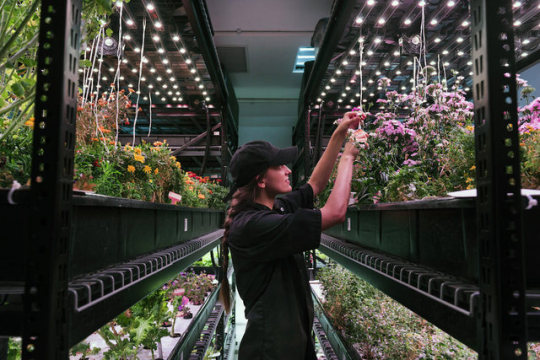
Can High-Tech Indoor Agriculture Transform Local Food?
CONTENT SOURCED FROM EDIBLEBROOKLYN
On one of those unseasonable 40-degree days this April when there was soaking ice-cold rain followed by umbrella-wrecking wind, the weather inside a miniature indoor farm near Manhattan’s City Hall was balmy.
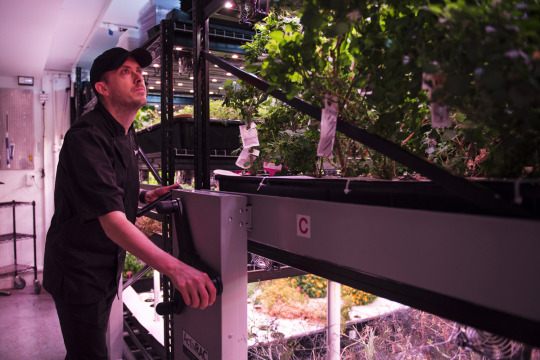
Farm.One CEO and founder Robert Laing (pictured above), in a black chef coat and jeans, surveyed the plants perfuming a 1,200-square-foot growing space, formerly a bicycle gym, in a building that also houses a veterinary clinic, a doggy swimming pool and Atera, a two-star Michelin restaurant serving dinner for $275 a plate. Space-saving expandable library shelves were lined with dozens of hydroponic plants grown in a water-based nutrient system instead of soil: snap peas, green sorrel, lemon basil, red mizuna, lemon gem marigold.
“Here’s one of my favorites,” Laing said, picking a leaf and a tiny flower snugly tucked beneath rows of bright LED lights. “It’s called “nepitella,” a flowering herb from Tuscany. Italian chefs are excited to see it in New York City because sometimes they haven’t seen it in years. It’s a little bit minty—the flowers have a powerful flavor for something so small.”
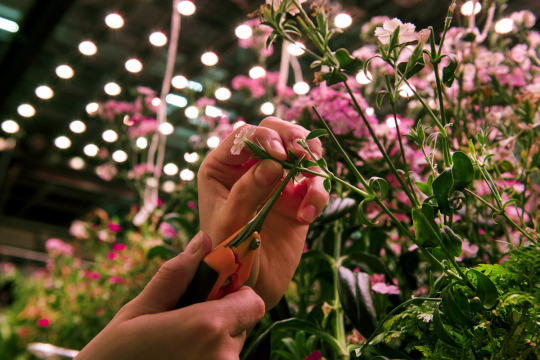
Laing specializes in selling such rare and unusual herbs, greens and edible flowers to mostly high-end restaurants—from Le Turtle on the Lower East Side to Daniel uptown and Atera upstairs. Those restaurants’ chefs are willing to pay a premium for hard-to-find produce harvested and delivered the same day.
“The growing climate in New York is difficult,” Laing said. “So chefs here really have a tough time getting rare produce—they have to ship it from miles away and by the time it gets here it’s not at its best. I really wanted to create a way to grow interesting things in the heart of the city year-round.”
In a town of eight million, Farm.One is part of a rising movement to cultivate produce where large numbers of people live by using high-tech systems and smart greenhouses placed at grocery stores, in basements and even inside cargo vessels. Leading restaurants have embraced these futuristic farms for a range of reasons, including variety, ingredient quality and virtually unlimited availability in all seasons.
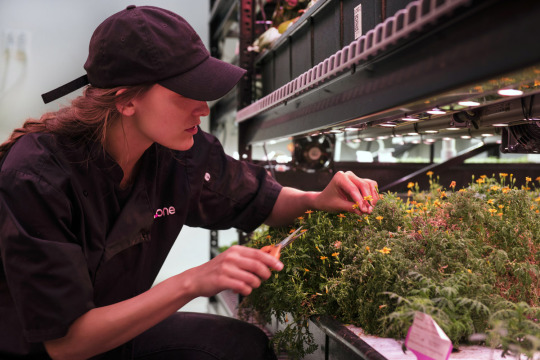
Critics, however, question whether high-tech farming in confined spaces will be destined to cater only to elite restaurants, especially considering the much bigger national marketplace flooded with cheaper produce from California and Arizona. Chefs also debate taste. Some are grateful to have local hydroponic produce to flavor their dishes in all seasons. Others swear the produce is inferior to herbs and vegetables from a dirt farm with the characteristic flavor of the soil where they grow.
There are also questions about what will happen if these indoor urban farms really take off, including whether they might undercut local farms on the metropolitan fringe. “The need to protect and preserve that open space is real,” says Dan Barber, the chef and co-owner of Blue Hill in Manhattan and Blue Hill at Stone Barns in Pocantico Hills, New York, and one of the pioneers of the farm-to-table movement. “To divert from that in any way seems to be a lost opportunity—even though I see the excitement of doing some salad greens in a shipping container.”
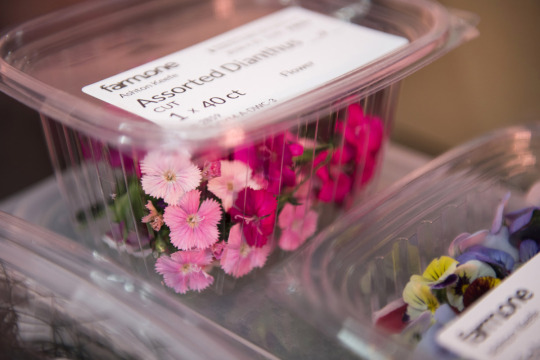
Urban farming business and distribution models vary almost as widely as the types of plants being cultivated. Farm.One’s website recently listed about 18 different types of produce ranging from a 10-count of yarrow or marigold leaves for $5 available to online customers to papalo (an ancient Mexican herb similar to cilantro) starting at $8.75 an ounce for restaurant orders only.
“We’re doing this at the high end because that’s where we know we can make money and have a sustainable business,” Laing says. He envisions expanding Farm.One in New York and in other cities with a continued focus on providing produce to restaurants and being a model to make such produce more accessible to consumers. “It’s really cool to think in a city like New York there are thousands of spaces like this,” he says. “The technology is there. I think the applications can spread.”
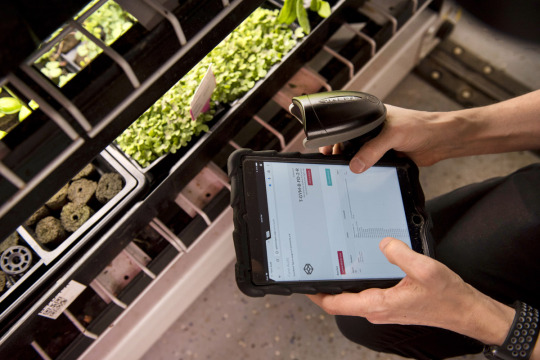
Indeed, technology is the central focus of most city farms. Smallhold, founded in 2017, pre-grows gourmet mushrooms that are finished in restaurants and a grocery store in leased climate-controlled cases lit by blue fluorescent lights and monitored and operated remotely by the company’s growers in Bushwick. Also located in Brooklyn, Square Roots, recently launched by Kimbal Musk (younger brother of Tesla boss Elon Musk) and his partner, Tobias Peggs, is helping young entrepreneurs use the latest innovations to farm in cargo vessels; a 320-square-foot container can purportedly supply about as much produce as a two-acre farm.
Gotham Greens, with locations in New York and Chicago, uses automation and sensors that can detect light levels, carbon dioxide, temperature and humidity to operate four rooftop hydroponic greenhouses producing about a dozen types of lettuces and herbs. The greenhouses represent 170,000 square feet of combined growing space.
In 2014 the company opened a greenhouse atop a Brooklyn Whole Foods—the first commercial-scale rooftop greenhouse integrated into a supermarket. “Our growers are harvesting, packaging and then the product goes down to the store,” Gotham Greens director of marketing Nicole Baum says. “We’ve reduced food miles to food footsteps.”
Despite those lower transportation costs, investors are concerned about the profitability of so many start-ups. “Most urban farms are costly and therefore their prices are higher than what one can pay at a grocery store for a field-grown product trucked across the country,” says Dan Pullman, managing partner of Fresh Source Capital, a company investing in local food and agricultural systems. “You’ve got to make money on this stuff. Otherwise it doesn’t work.”
Baum said Gotham Greens’ prices are competitive with local and organic lettuce brands, about $3.99 for a 4.5-ounce container. Still, the company is a small-scale producer vying for consumers faced with a financial decision: pay the price for local organic, save 50 cents by purchasing a well-known organic brand, or a whole dollar for conventional greens from California or Arizona.
“There is always a consumer who will pay for value,” Pullman says. “Gotham may be in a good position because they’ve got loyal regional markets, but replacing lower-cost producers will be tough.”
A puree of Gotham Greens’ basil spinach currently stars on one of the atbreads served in Gramercy Tavern. “They’ve given us access to harvested greens in even the cold weather months,” executive chef Michael Anthony says. “That makes for exceptional high quality from a restaurant perspective.”
But some chefs say hydroponic lettuce will never rival the taste of lettuce grown in the earth. “I’ve never tasted any hydroponics that I think are really that delicious,” says Dan Barber of Stone Barns, which grows some of its lettuce in a nearby greenhouse and sources more from local farms. “Sure, the quality in terms of the way the product looks and the yield can be more consistent by being contained because you’re not subject to the whims of nature—but that doesn’t mean it’s better.”
What’s more, Barber adds, “the side effect of the excitement about indoor farming takes away from the investment and intellectual capital in creating systems for agriculture that are still very viable surrounding major metropolitan areas.” For him, it’s important to preserve the farmscape, healthy agriculture and organic philosophies based on sustainable land use and feeding the soil, not just the plant.
Dave Chapman, owner of Long Wind Farm in Vermont, is on the board of the Real Organic Project, an organization created to challenge the USDA’s recent decisions to certify hydroponic produce and scrap rules about animal welfare. While he’s not opposed to hydroponic farming—“some of my good friends do it”—he wants the methods to be transparent so consumers understand the produce isn’t grown in soil. “This is happening,” he says. “We can’t be food fascists—don’t grow that way! As long as farmers are being honest about how they’re growing, people will decide over time what they think.”
If the glow of LED lights in pockets around the city is an indicator of how much New Yorkers appreciate freshly grown local produce, the urban farming trend may continue to spread. As long as those farms are profitable, entrepreneurs will invest, restaurants will buy—and diners will clean their plates.

Produced in collaboration with the Food & Environment Reporting Network, an independent, non-profit news organization.
60 notes
·
View notes
Text

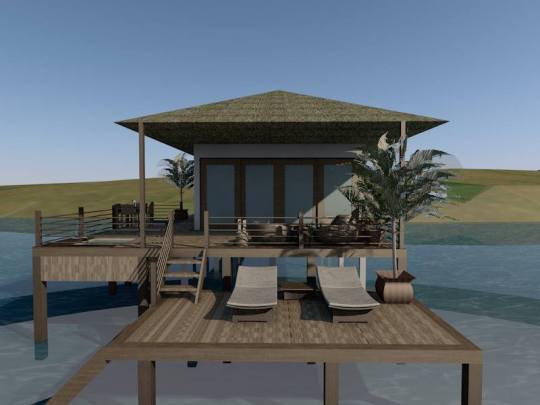
Bask under the glorious Palawan sun with the first of its kind Avara Nature Yacht Club.
Imagine this: The sound of waves crashing on the shore and the sunlight peeking through the window wake you up on a lazy Saturday morning. You slowly open your eyes, afraid that you’re just in the middle of a dream. But you’re not. You stand up as you feel the gentle sea breeze touch your face. You go out of the porch and look at the horizon. You take your time to enjoy the beauty of the blue skies and the deep sea. The yacht will be waiting for you whenever you’re ready, anyway. That’s the promise of Avara Nature Yacht Club—the easy life of the seaside.
Established by the Seaside Premier Development Corporation, Avara is the first of its kind nature and yacht club located at Calauag Bay in Taytay, which was Palawan’s first capital.

The plan for the exclusive resort was formally unveiled at the Grand Hyatt Manila led by its President and CEO Ms. Veronica C. Young.
“After many months of sailing and voyaging aboard bangkas and riding waves, we found the perfect island in Taytay, Palawan to be the home of our pioneering project. It is with a great pleasure to present to you tonight, Avara Nature and Yacht Club - the first of its kind in the Philippines, bridging the middle class to the lifestyle of the rich and famous. As Seaside Premier Development Corporation’s flagship project, we aim to redefine seaside living, where nature meets luxury,”
she said in her opening remarks.
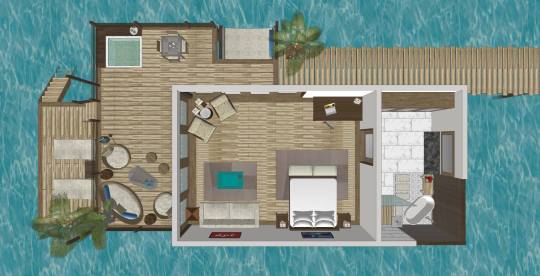
Avara, which means Sunshine Island, is an eco-luxurious resort that use solar panels as a source of renewable energy, utilize a recycled water treatment system, maximize a hydroponic garden, and take advantage of other eco-materials available.
Its accommodation is inspired by the Maldivian architecture. Members can choose to stay in a one-bedroom Water Villa with jacuzzi, two-bedroom Water Villa with private infinity pool, or one-or two-bedroom Beach Casitas. Aside from the villas and casitas, Avara members will also have an exclusive access to a two-bedroom yacht with crew for an overnight stay or for cruising around the island and nearby areas. Avara’s yacht features two cabins and a family room in the lower deck; a living room, a kitchen and dining area, and a plunge pool in the main deck; and an open dining space and a sun deck in the fly bridge.
The Avara Island has nothing but the best facilities for its members. Guests will first experience the Avara service upon their arrival at the dock or the harbor. But the ultra-luxurious resort also has a helipad for those who will be coming in by air. VIPs also have the option to skip the reception and go straight to their accommodation. There will also be a boardwalk open for development to entrepreneurial Avara member. Meaning, Avara members can also be concessionaires to open their own business—it could be a coffee shop, a grocery store, a bakery, a souvenir stop, and similar ventures. As support to the member-concessionaires, Avara will ensure that the business will be the island’s lone supplier for the specific product. The island can also accommodate as many as 100 guests at their main dining area and at the grill restaurant. But guests will have more dining options since Avara includes a poolside bar, a seaside bar and lounge, picnic areas, and private dining venues. Avara is fully equipped with a gym, a water sports center, a tennis court, and a golf course to those who want to keep up with their fitness routine. The island also has a playroom and nursery, spa and massage cabanas, a bonfire area, a clinic with an in-house doctor and nurse, and a gaming area for the enjoyment of the Avara members. At any given time, Avara will host up to 300 members to ensure quality service.
As a promised paradise for those who love the beach, Avara offers a myriad of water action such as diving, snorkeling, kayaking, jet-skiing, banana boat riding, stand-up paddle boarding, wind surfing, scuba diving, island hopping, and fishing in coordination with neighbor islands. The resort also provides options for on land activities like trekking, biking, and vegetable picking. There are also a lot of activities that Avara members can enjoy outside its vicinity. After all, Taytay, Palawan boasts of picturesque sites like the Canique Waterfalls, the Lake Manguao, the Irrawaddy Dolphins in Malampaya Sound, the Fuerza de Santa Isabel, and the Church of Santa Monica. Taytay is also hope to a paradise-like hidden valley that gives tourists a bird’s eye view of the pristine, idyllic coastal areas of the municipality.
mikewillfly
4 notes
·
View notes
Text
Led For Horticulture – Using Advanced Technology For Gardening
Hydroponics advanced out of a blend of need and want. We want new tomatoes, we want new basil, we need some place to develop them since we don't all live on ranches any longer. The more we catch wind of plants being covered in wax and pesticides, the more we stress over those substances getting into our youngsters and ourselves, and we need some approach to make certain of our food sources.
While it's unfeasible to believe that we could go from purchasing our food at the store to developing everything in our condos, it's ideal to realize that we can enhance a portion of our produce thusly. Popular sauces, for example, or your very own spice garden for new cilantro, basil and oregano are an enticing motivation to go Hydroponic with the use of led for horticulture.

For fanatic, regular gardens just individuals, hydroponics may not be your favorite. In case you are utilizing plants that are local to your area, you just plant your seeds and let nature follow all the way through. Be that as it may, for some in northern environments, the hang tight for spring is excessively far off. These individuals like the plant life that innovation can bring to their homes.
Before this author knew what hydroponics even was, she was purchasing "Plant matured, hydroponically developed tomatoes" at the nearby supermarket because of their unrivaled shading, surface and flavor. They were reliably radiant red, succulent, and without spots.
You are greatly improved utilizing led for cucumber with an air-cooled reflector to accomplish most extreme yields. Try not to accept the publicity of the led for horticulture and fluorescent light manufacturers.
0 notes